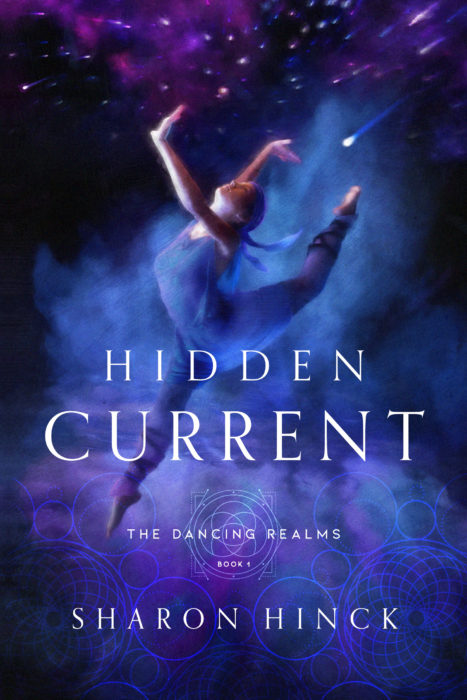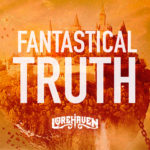Didn’t Like That Halftime Show? Our New Podcast Episode Explores the Purpose of Dance
Fantastical Truth has a new podcast episode? Why, it must be a Tuesday at Lorehaven.
In episode 3, we explore Sharon Hinck’s newly released fantasy novel Hidden Current.
Podcast: Play in new window | Download
This island world has a lot of dancing going on. The good kind. And otherwise. But not the kind of dancing you’d see during, say, the halftime exskinvaganza of a major American sporting event.
But I believe we can’t condemn any abuse of dance and performance without some idea of what these things are meant for.
What is the purpose of dance and other creative expressions in God’s world? Because, if we can’t instinctively and simply answer these questions with heartfelt biblical rationale, then we may as well give up and let the Footloose-type villains have the last word.

“Sharon Hinck’s fantasy dances to the rhythm of our Creator’s heart.”
—Lorehaven magazine (read full review)
Here’s an excerpt from our show notes:
Some Christians from sheltered/legalistic environments sometimes wake up and think something like: “Hey, all that stuff was actually good all along, so let’s just accept it all!”
Well, that’s a baby step in the right direction.
But you have to run the whole way, away from the notion of “it’s all evil” but past the equally silly notion of “it’s all good.”
You have to get to the biblical concept that God gives these gifts, man corrupts them, but Jesus redeems them.
No spoilers, but I love how Sharon Hinck explores this in particular in Hidden Current.
Get the whole episode here (or there). You can subscribe to the Fantastical Truth podcast wherever podcasts are “sold.”
Meanwhile, let us know how you first discovered fantastical fiction. We’d like to feature your comments on a future episode.
“Dancing” at least privately and non-corporeally in my own mind, where you cannot see,
Stephen












































Sharon’s the real deal. Go buy her book!
Off topic, but at least vaguely related: I have been having more thoughts about the concept of high art vs low art, fluff content, happy nice time trash, etc, and what role sens(sex)uality plays in these.
Is it possible for a thing to be pr0n but also have legitimate artistic merit? We are used to the simplification that respecting a woman means not sexualizing her, but shall we explore the space between, where a woman can be intelligent and fully realized emotionally, but also naked?
Granted, this is an easier concept for ladies of the straighter persuasion, since hot men are not nearly as sexualized in art as hot ladies (thanks, male gaze). Like, forreal, when I faff around the midcentury/modern art galleries, it’s all like thanks dude from the 60s, more sexualized women in art, how original, this totally hasn’t been done before.
Okay, maybe I might as well just write the articles and plop them in Stephen’s inbox.
Of course nudity can be artistic. That’s why it’s used. But most of the time, in modern settings, it’s used in a primarily pr0nographic manner. And, sorry, but pr0n offers no real value, and serves no real positive purpose. It is dehumanizing and immoral, while art should be essentially humanizing and moral (in the sense that John Gardner used the term). The end goal of most nudity is not art, but titillation under the guise of art. That = flawed art. The presence of pr0nography damages the art itself, rather than enhancing it. It’s the same as Pilgrim’s Progress’s use of imagery. (Uh-oh, here come the holy police to spank me for drawing a parallel between Pilgrim’s Progress and pr0nographic art) Both are propaganda. That’s what I mean. Propaganda = flawed art. No Christian in their right mind should ever stoop to propaganda (the technique Hitler used) to spread any Biblical concept, ever. It destroys itself. This is a massive pet peeve. Do we not trust in the message itself to be strong enough? What about Paul’s comment that he didn’t use all the flourishes of oratory, lest the cross of Christ be emptied of its power? The WAY something is communicated is as important as what’s being communicated. And propaganda, or pr0n, are flawed ways to try to communicate something of value. Even flawed ways to communicate that WE have value.
Welp, most things are propaganda, especially in a capitalist society. I guess we’re screwed.
But it’s a little hilarious how binary that thinking is. Would propaganda be nearly as effective if it didn’t contain trace amounts of art? Would conspicuous consumption be effective if it weren’t at least a little pleasing to our magpie brains? Propaganda is meant to persuade, and everybody first processes things as an emotional reaction before a logical conclusion (thanks, amygdala). Dude, our idea of art and beauty is also influenced by propaganda. Y’know how chunky ladies were considered beautiful back when the average person (ie dirty peasant) was half-starved and skinny?
The reason we might think Pilgrim’s Progress is tacky now is that we’re far enough removed from the context in which it was fresh and compelling (ie we are not illiterate English peasants). But what makes Bunyan tackier than CS Lewis? Lewis can be considered a bit of poseur with his over-reliance on Classical philosophy, which mostly has traction in society because it’s perceived as upper-class and educated.
I would argue the technicals of aesthetic like symmetry and the Golden Ratio is maybe only 30% the art’s social value, while the remaining majority is whether or not it is perceived as upper class. Art is already tainted. But what makes a well-designed ad campaign (minus naked ladies, for arguments’ sake) less degenerate than well-designed pr0n? Is the anti-vaxx movement any less degenerate for preying on people’s fears and concerns for their children than a liquor ad is for using some cleavage?
Somewhat relevant ContraPoints vidya:
https://www.youtube.com/watch?v=jD-PbF3ywGo
But I’m actually more interested in a more happy nice time version. We know the dumb slvt trope and the mean girl trope, but what happens if we have an nice girl who likes over-elaborate makeup and rhinestones? Like, play with it even more. Maybe she’s book-dumb but emotionally intelligent and also the mom-friend. Maybe she’s a v*rgin, or maybe she likes fooling around with her steady boyfriend. Maybe she’s Galko-chan from Please Tell Me, Galko-chan. Maybe she’s Aiura from Saiki. Why can’t we have some more of that?
And here I find myself in rare agreement with Notleia. At least in part, though I’m going to go a different direction in the end than her. My historical study of the Cold War for my MA in History (that I referenced in my post, What Kind of War Does the Devil Fight?) included a hefty tome on the use of “public diplomacy” during that period. Public diplomacy really is propaganda–though “propaganda” has become a pejorative for “getting your message out” and only refers to getting your message out in a blatantly ham-fisted way for some people.
But during the Cold War, “public diplomacy” paid for things like touring exhibitions of American and other Western art, museum displays of technological advances, and touring Jazz musicians. Anything that could create a positive association for the West was effective and didn’t have to include any overt message at all. But also, on the one hand it served the interests of public diplomacy to try to be an objective source of news with high journalism standards, because that conveyed the message “America can be trusted”–Voice of America. On the other hand, it also served public diplomacy to spread rumors and innuendo and be more aggressive in promoting the values of the West–Radio Free Europe. Both subtle and non-subtle methods were applied in differing contexts.
The advertising industry has learned in a massive way how to use the methods of propaganda, i.e. public diplomacy, i.e. messaging, i.e. information operations (in US military terms). When the Superbowl played a Jeep commercial repeating part of the popular movie Groundhog Day, the point was to create a positive association between the vehicle and the warm, familiar feeling and laughter the commercial evoked. A relatively subtle approach. But commercials also include infomercials that for sophisticated viewers are blatantly fake, but which still persuade a certain audience.
While I believe very much that Christian artists should be honest–that our honesty is more important to us than it is to any commercial industry–I acknowledge some Christians will want to be more blatantly “preachy” and come across a bit like what you’d call “propaganda.” I actually think that’s OK–it has a purpose in its context. But others will want to be more subtle. Which is also OK.
But even if you decide you dislike the crassness of “propaganda” you should recognize that every single piece of art produced has an effect of “public diplomacy” for someone. That’s just being realistic. That’s true whether we like that or care about that or not.
So we as Christian producers of art should work to make sure our “public diplomacy” is for God, even if very subtly. (Because not every inspiration is good to pursue!)
(As for the Superbowl show, say what you like about female empowerment, Latina empowerment, or anything else, I would say Satan wanted to be sure an encouragement to sin was in there in the mix of influences for the halftime show.)
Of course it’s binary. Because art and pr0n are two separate things. They can coexist, but they’re not the same. It’s obvious what makes Bunyan tackier than Lewis, so who even needs to answer? And I’m not arguing that Lewis is the paragon of great art. All I’m saying is that the presence of pr0n never adds artistic value. Anything that makes a work of pr0n artistic is not the pr0n itself. You’re arguing over something I wasn’t arguing about. Per usual…
Huh. I’d start asking questions to sound out the boundaries between what you mean by both art and pr0n, but that would get graphic pretty quick.
But in short, I think to some extent pr0n, like beauty, is in the eye of the beholder.
America is pretty sensitive about female toplessness, but it’s way less of a concern in other parts of the world.
Right. But it’s pretty irrelevant to the basic point that I’m trying to get at, which is that they’re different, and that they achieve goals that are opposed to each other.
But that’s like the problem I’m having to understand you. What are the different goals, then? Generally, the function of art is to elicit an emotional response. Pr0n just targets more specific emotions.
Unless you’re applying extra parameters to “art” to mean “High Art with Capital Letters and Ideals and Noble Thoughts”? But even then I’m not entirely convinced.
Or maybe it’s just because you haven’t seen the right kind of pr0n, I dunno. It is pretty rare.
I don’t think the function of art is to elicit an emotional response. If that were the case, then yes, pr0n would be art. But I think the function of art is instead to communicate truth in beautiful ways. I think it should be essentially life affirming. If it isn’t that in some way, it just doesn’t accomplish anything of worth, and art, I think, is something that accomplishes something of worth. What I mean by all that would take, probably, a dissertation, and I don’t think I have the ability to explain it well enough that you’d be “convinced” — which, really doesn’t matter anyways. It’s my opinion, and it’s not fully-founded on rock-solid thinking, but personal experience and a lot of late-night musing. As I said before, pr0n is dehumanizing and communicates that humans are something to be used for pleasure. It doesn’t affirm life. There’s SO much more to life than sexual appetites. Pr0n’s purpose is to so inflame that appetite that all the other appetites and elements of life get shunted to the side. Some rare humans can watch it and be unaffected. That’s irrelevant. The base purpose of it is at odds with what is life-affirming. And yes, that means I think the intent of the artist actually matters. There are kinds of “life” that are as good as being dead, like when you’re so hopeless and joyless that everything just feels completely dead. I think the purpose of art is to affirm what is life-giving, to affirm the richness of life in a way that can be life-giving. Sort of… idk, a refreshing perspective, or the wonder of a fantasy world that lifts your spirits. Horror can affirm what’s good and true. Art that covers sexuality and sensuality can do this. But there are certain boundaries that are better left uncrossed, because they dip into things that are too obviously destructive to people. And yes, that’s ambiguous for a reason, because certain art is good for some people and destructive for others. So, there’s personal responsibility in every human who consumes art for consuming it, and personal responsibility for every artist who makes art to be consumed. Like… if you struggle with pr0n, don’t go watch movies with nudee-scenes. If you do, you’re an idiot. But some people can make and watch art that includes nudity without doing anything inherently damaging or sinful. It may all sound like a bunch of mumbo jumbo ambiguous hogwash if you’re looking for an intellectual essay, but I think if you’re honest with yourself you’ll admit the reasons why you love works of art is that they do these kinds of things in you. They affirm what’s good and what’s true. Sometimes that can be that we like being made to feel sad, because we can experience it in a way that’s strangely cleansing. There’s a lot of shades here. It’s complicated. And I’m sure everything I just wrote will turn sideways on the way from me to you, and you’ll interpret it in some way I didn’t intend. It takes too much work to make my rambling thoughts both coherent AND convincing. And I’m too lazy to continue trying (and probably failing).
Yeah, you’re working with a narrower interpretation of “art” than I expected. I do have a story (with sexy stuff in it) in mind to recommend and illustrate what I mean by blurring the lines between art and pr0n, but 1) I’m not sure of the availability, because it started out on deviant art by a Croatian guy, and 2) it has teh ghey in it.
Interesting. I tend to think of art more as a means of expression or communication. Or perhaps an interesting way of relating the human experience. Art is a thing, a sort of tool to meet those ends. It SHOULD be life affirming, just as hammers SHOULD pound in nails. But hammers don’t stop being hammers just because you hit your finger with one. Likewise, something doesn’t stop being art just because it’s immoral.
People tend to like art so much that they believe it always has to be this wonderful thing, so when the thing in question ISN’T wonderful they want to say it isn’t art. I’m definitely not saying that pr0n is art, but some people could potentially turn it into that, whether or not that’s wrong.
Defining art demands a narrow interpretation. Either that, or you end up saying everything is art. I agree that art is a thing. I also believe it works on a continuum. A sliding scale that says at one extreme, this is pure art. The other extreme, this is pure not-art. To that, I think that the things thrown into an artistic work (like pr0n) constitute “non-art elements” tacked onto a piece of art. At times, those non-art elements work against the life-affirming, beautiful truth communication (and I don’t mean beautiful as in “aesthetically pleasing”) which I think is what art really is. In between is where all “art” falls. But it has to be that way, doesn’t it?
IIRC, you got a business degree. That would explain a lot about your perspective. But a lot of us are liberal arts dorks who were required to write essays about the dead white guys who established the first canons, and then all the people who hate those dead white guys and want to abolish/modify the canons. There’s an entire Thing of context that you’re zipping past in order to make your point.
More tangent: what about folk art? Right now I’m doing a cross stitch of a Grumpy Cat meme, how would you classify that on an artistic spectrum?
Grumpy Cat meme qualifies for all the things, of course… folk art is art. FYI, I spent most of my time at business school touring, playing gigs, and doing session work as a full-time drummer. I made a living doing it before realizing touring was not for me (or my family), and so some of this “What is art?” comes into my reasons for being irritable at people who say that rhythm alone isn’t music, or isn’t art. The definition still works for that. Even though rhythm doesn’t communicate any words, or logical argument, etc. I see truth (as used in the definition given above) as being broader than that. Ex. I love progressive metal. I think some of it is trash, but some is wonderful art that affirms reality, and even affirms certain emotions that are considered “taboo” but are actually perfectly legitimate. From what I can tell, I don’t think our ideas are probably that far off… just a different way of thinking of a similar thing.
Quite a long time ago, I had been working on a 50 page draft trying to work out these thoughts. I need to dig it up and see if it’s coherent.
Post scriptum braining: y’know how they say art is political? I’d rather say that both art and politics are sociological/relational. Art does not exist in a vacuum (not even from pr0n).
Totally. I think it’s because art has to be experienced. It’s a relational/emotional/intellectual/justallaroundhuman thing.
Can’t seem to post comments from my pc still. Blech. Anyway, the book sounds interesting. I did take dance lessons for quite a few years during early childhood. It wasn’t my thing, so I’d probably enjoy this novel more for the commentary on art, religion, character growth and critique of society more than dance itself.
Kinda wish this book came out while I was in highschool, though. I had several friends that were really into dance, so this book might have been a good birthday gift for them.
I grew up around a lot of fairly conservative people, but I didn’t see them being critical toward dance. At the most, it was usually just people criticizing moves that were more on the sexual or inappropriate side. And then when I was little there was one reading textbook about a girl that lived like a century or two ago. Her friends started dancing a Cakewalk during recess, and an elder came in and discouraged them. Later on the girl reflected on it and realized that she started spending all her spare time thinking about the Cakewalk and therefore forgot to pray. So that was an interesting look into how people might have felt about that stuff back then.
I never thought dancing was bad. When I was about five my Mom actually put me in dance lessons because she thought they would make me more coordinated/less clumsy and accident prone. And many of my friends took dance lessons/enjoyed dancing way more than I did. Interestingly enough it never truly clicked with me, though. Sometimes it was fun, but in the end I never cared enough about it to work hard and gain skill in that area.
((Edit. Because apparently, even though the site hasn’t been letting me post comments from my computer, I can still EDIT comments from my computer if I posted those comments from my phone… Anyway, notleia, this was meant to be a reply to your post.))
Well, pretty much anything can be artistic. That said, from what I recall of that one beginning media law class I took years ago, there was some interesting historical stuff around deciding what legally counts as pr0n. One person was even like ‘I know it when I see it.’
https://en.wikipedia.org/wiki/I_know_it_when_I_see_it
That quote is sort of a good reminder of how complicated this subject can get. Like, yes, some things are very obviously pr0n, but exactly when does something start being pr0n?
From what I recall from that media law class, there’s several ‘tests’ that the government uses(or at least used) when deciding if something is pr0n. One was whether the thing in question has a reasonable amount of artistic/scientific/etc merit. Another was whether it was made to serve the prurient interest.
The government also takes into account social norms /what the general populace considers offensive. Still, from a general legal standpoint(obviously I’m not a lawyer, just pointing some things out) it looks like it’s hard, if not impossible, for something to be pr0n if it has true artistic, scientific, etc merit.
On a daily basis, though, it looks like a lot of people already make things that ARE arguably pr0n but full of artistic merit. I haven’t seen/read Game of Thrones, but a lot of people point out that it has sex AND quality story telling. Though I’d guess that there’s a lot of people that focus their attention on only one of those aspects. Also, I heard of one author that openly says she writes pr0n novels, but makes sure her novels are legitimately high quality stories. Presumably enough that she’d feel confident in saying that her novels would be entertaining even if the sex scenes were removed.
But then there’s things that are going to serve as pr0n for people even if there’s no real sexual content in it. Like, sometimes people will fantasize about someone they see walking down the street, or movie chars innocently going about their daily lives. It’s not just guys that fantasize like that, either.
People’s fantasies can be a little odd or even annoying sometimes, though. Like, a story can be well made and full of great characters, but then there’s a subset of readers that are primarily focused on which guy chars they consider hot. They have every right to enjoy the story as they please of course, but it’s still a weird and interesting part of human nature that may be detrimental at times.
In real life I’ve seen one or two women have calendars of shirtless men in their offices. That sort of does strike me as unprofessional. And, of course, if it’s sexist for men to have calendars of women in bikinis, shirtless men calendars would technically be sexist too. But someone might try to argue that either of those calendars have artistic merit from a photography standpoint, even if they arguably objectify the people in them.
Oh hey, I wanted your opinion on a vidya, and I would have posted it on your blog but I don’t like Blogger’s comments system. It’s hugely inappropriate, but it is also funny and brings up a few interesting points. So therefore having broadcasted the inappropriateness of this vidya, even more than Contrapoints’s, I absolve myself of any charges that come from anyone but Autumn clicking on it. For one, she’s probably the only one who’ll understand the otaku vocabulary. I set up a new email at notleia@protonmail.com, so we can discuss this away from here as soon as I get a contact for you.
(I do kinda worry about hurting your sensibilities, because it has taken me quite a few years to become this flippant about sex and I want to be considerate of people who are doing their best to engage this content in an earnest manner. Tho I have drastically less motivation to care about the sensibilities of wanna-be moral scolds.)
Thank you for asking my opinion. I’ll listen to the video later and email you. I’m ok with listening to something like that every once in a while if it’s for the sake of conversation. It’s usually easier for me to listen to/read something awkward than it is to see something, though, so I might not be looking at the screen while the video plays. Like, videos are fine, but if there’s some visual joke and I miss it it might be because I wasn’t looking.
Sent you an email. Leave me a comment here if you don’t receive it.
Nope, I can’t find it. It’s not even caught in my spam filter.
Sent another one. Let me know if you got it.
We good